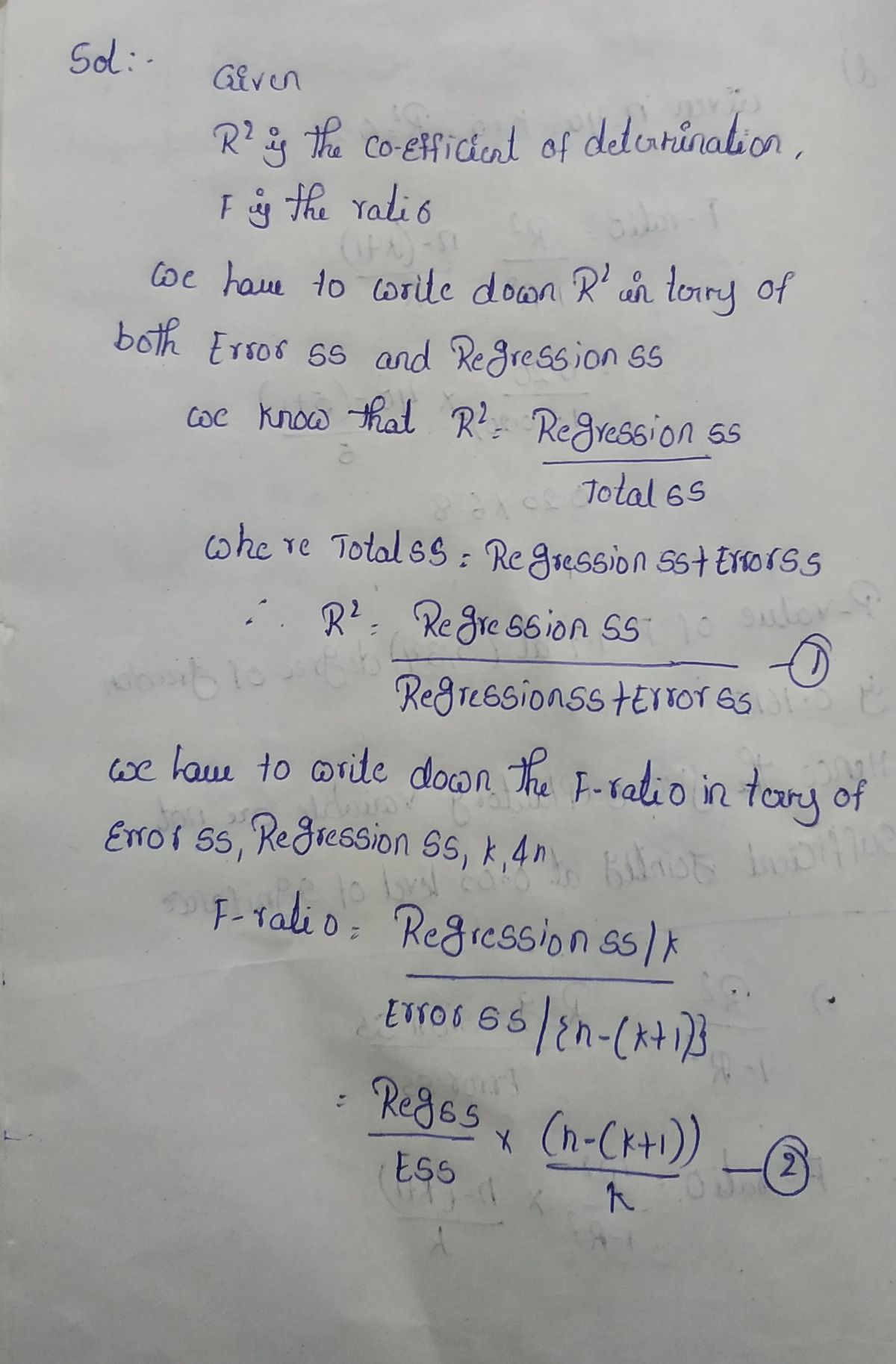c. Establish the algebraic relationship R? n – (k + 1) F-ratio 1 - R2 k
MATLAB: An Introduction with Applications
6th Edition
ISBN:9781119256830
Author:Amos Gilat
Publisher:Amos Gilat
Chapter1: Starting With Matlab
Section: Chapter Questions
Problem 1P
Related questions
Question
![**Title: Understanding the Algebraic Relationship in Statistical Analysis**
**Main Content:**
**c. Establish the Algebraic Relationship**
In statistical analysis, it is often necessary to establish algebraic relationships to gain insights into data behavior. One such relationship is the calculation of the F-ratio, which is used in the context of analysis of variance (ANOVA) to compare variances and assess the significance of statistical models.
The formula for the F-ratio is given by:
\[ F\text{-ratio} = \frac{\frac{R^2}{1 - R^2}}{\frac{n - (k + 1)}{k}} \]
**Explanation of Variables:**
- \( R^2 \) is the coefficient of determination, which represents the proportion of variance in the dependent variable that is predictable from the independent variable(s).
- \( n \) is the total number of observations or data points.
- \( k \) is the number of independent variables or predictors in the model.
This formula is crucial in determining whether the predictors explain a significant amount of variability in the response variable, influencing decisions in hypothesis testing and model evaluation. Understanding and applying this relationship can aid in more accurate data analysis and interpretation.](/v2/_next/image?url=https%3A%2F%2Fcontent.bartleby.com%2Fqna-images%2Fquestion%2Fa89dc4a0-3781-41ca-831d-61fcc7d61ff9%2F9813d5b1-8b36-4c9d-9aab-4adff5a62aa0%2Fop100ie_processed.png&w=3840&q=75)
Transcribed Image Text:**Title: Understanding the Algebraic Relationship in Statistical Analysis**
**Main Content:**
**c. Establish the Algebraic Relationship**
In statistical analysis, it is often necessary to establish algebraic relationships to gain insights into data behavior. One such relationship is the calculation of the F-ratio, which is used in the context of analysis of variance (ANOVA) to compare variances and assess the significance of statistical models.
The formula for the F-ratio is given by:
\[ F\text{-ratio} = \frac{\frac{R^2}{1 - R^2}}{\frac{n - (k + 1)}{k}} \]
**Explanation of Variables:**
- \( R^2 \) is the coefficient of determination, which represents the proportion of variance in the dependent variable that is predictable from the independent variable(s).
- \( n \) is the total number of observations or data points.
- \( k \) is the number of independent variables or predictors in the model.
This formula is crucial in determining whether the predictors explain a significant amount of variability in the response variable, influencing decisions in hypothesis testing and model evaluation. Understanding and applying this relationship can aid in more accurate data analysis and interpretation.
Expert Solution
Step 1

Step by step
Solved in 3 steps with 3 images

Recommended textbooks for you

MATLAB: An Introduction with Applications
Statistics
ISBN:
9781119256830
Author:
Amos Gilat
Publisher:
John Wiley & Sons Inc

Probability and Statistics for Engineering and th…
Statistics
ISBN:
9781305251809
Author:
Jay L. Devore
Publisher:
Cengage Learning

Statistics for The Behavioral Sciences (MindTap C…
Statistics
ISBN:
9781305504912
Author:
Frederick J Gravetter, Larry B. Wallnau
Publisher:
Cengage Learning

MATLAB: An Introduction with Applications
Statistics
ISBN:
9781119256830
Author:
Amos Gilat
Publisher:
John Wiley & Sons Inc

Probability and Statistics for Engineering and th…
Statistics
ISBN:
9781305251809
Author:
Jay L. Devore
Publisher:
Cengage Learning

Statistics for The Behavioral Sciences (MindTap C…
Statistics
ISBN:
9781305504912
Author:
Frederick J Gravetter, Larry B. Wallnau
Publisher:
Cengage Learning

Elementary Statistics: Picturing the World (7th E…
Statistics
ISBN:
9780134683416
Author:
Ron Larson, Betsy Farber
Publisher:
PEARSON

The Basic Practice of Statistics
Statistics
ISBN:
9781319042578
Author:
David S. Moore, William I. Notz, Michael A. Fligner
Publisher:
W. H. Freeman

Introduction to the Practice of Statistics
Statistics
ISBN:
9781319013387
Author:
David S. Moore, George P. McCabe, Bruce A. Craig
Publisher:
W. H. Freeman